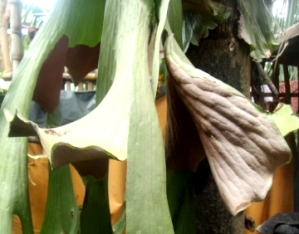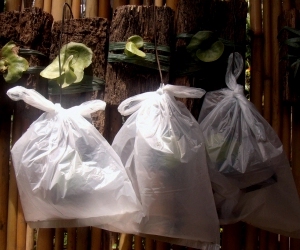The Giant Staghorn Fern or capa de Leon (Platycerium grande) can be propagated deliberately from spores even without following the advanced, but meticulous, procedure in fern spore propagation.
The latter involves the sowing of mature spores on sterilized fragments of “cabo-negro” or “paslak” and maintaining humid conditions all throughout until germination and seedling emergence.
Mass propagation by spore can also be done through tissue culture.
Cabo-negro is a local term for the indigenous, black, trunk-like columnar plant organ probably consisting of the root of a giant terrestrial fern.
It was only by accident that we discovered that the Giant Staghorn can be mass-produced sustainably by exploiting its natural method of propagation.
We’ve had several large Giant Staghorn ferns in the backyard at General Santos City since about 40 years ago, but we always grow these from starter plantlets or juvenile ferns which we bought from private suppliers.
Until recently, the city had a hot climate with scarce rainfall.

Then one day about a year ago, my mother Mama Maxi noticed plantlets, with only overlapping basal fronds, growing from the side of a lone, upright cabo-negro which has been used as support for epiphytic orchids for several years.
The cabonegro was about 5 meters away from a huge Giant Staghorn Fern which clasped the trunk of a Fishtail Palm.
Orchids grew on top of the cabonegro and so it was regularly sprinkled with tap water.
The Staghorn itself regularly produced spores from the underside of its foliar frond.
My mother taught us the basics of gardening. At 74, she still tends the various ornamental crops, seedlings, and vegetables in the backyard.
She extracted the fern plantlets from the cabonegro with the help of a knife, including a segment of the cabonegro which held the roots of the fern.
She then attached it to a segment of a coconut husk.
Having observed the natural way in which the Giant Staghorn Fern reproduces, we developed a protocol to propagate the fern from spores using readily available materials.
We followed these procedures:
The Protocol to Propagate the Fern From Available Materials
1. Harvesting of spores
We harvested the mature spores by scraping those “browns” from the underside of the fronds, placing them in an envelope, and allowing them to dry by air-drying without closing the envelope.
Otherwise, we cut the spore-containing frond, divide it into smaller segments, inserted the segments in a paper envelope, and dried them by exposing the envelope to full sun.
After a few days, the spores separate from the fronds.
These dry spores can be placed in a closed glass jar or plastic canister and stored under refrigeration.

2. Sowing of spores and care
We dusted the dried spores on the sides of the same standing cabonegro.
The cabonegro was kept moist by regular watering.
Care of the sown spores and plantlets, therefore, became incidental to the management of orchids that grew at the top portion of the cabo-negro.
3. Extraction of fern plantlets
It was ascertained that the green growth on the side of the cabonegro belongs to the Giant Staghorn Fern.
When several plantlets reached a horizontal width of about 4-5 cm, we extracted them from the cabonegro.
A chisel was used because a piece of cabonegro that held the base of a plantlet had to be included.
Where several plantlets grew tight, it was necessary to slice one single but a relatively wide and somewhat flat segment of the cabonegro.
The plantlets were then separated individually, taking care that as much as possible each plantlet remained attached to a segment or at least a strand of cabonegro.
Sometimes it was possible to pry the cabonegro segment by hand to separate a plantlet.
But in most cases, the cabonegro had to be sliced with a sharp tool or with a pruning shear.
4. Transplanting of fern plantlets
Each plantlet + cabonegro segment was immediately immersed in water, pressed on a small piece of a decomposing coconut husk, and tied to a small slab of coconut trunk or wood lumber (we used rejects) or split bamboo.
The coconut trunk segments (or substitutes) with attached plantlets were then watered and inserted into plastic bags.
Each bag was closed tightly and kept under shade for at least 7 days without opening.
This is an application of the plastic tent method, also called “bukot” or “kulob” system, which ensures that the plant is kept under high humidity, a condition that favors healing from shock and root development.
5. Care and management
The plastic bags were monitored daily to ensure that moisture inside each bag was maintained. But all bags remained cloudy from outside instead of being clear.
This indicated that moisture remained and just circulated inside.
After at least 7 days, the plastic bags were opened and the plantlet-bearing slabs were removed.
The slabs were hung under partial shade and tended intensively. Care mainly involved regular watering.
Disclaimer: We are not promoting the harvesting and trading of cabonegro. We are in fact experimenting with other possible growth media for fern spore germination and growth.
